Are you ready for something more unusual and vintage? I hope you are because the following article is for one such car – the 2nd generation Saab 900. Maybe some of you know that the Saab Automobile company originated from the aerospace and defence corporation Saab AB in 1945. Since its inception, the Swedish car brand decided that its primary marketing focus point should be this fact, which led to some peculiar design decisions and commercials. Either way, this uncommonness had earned Saab some die-hard fans who associate themselves with this left-field way of thinking.
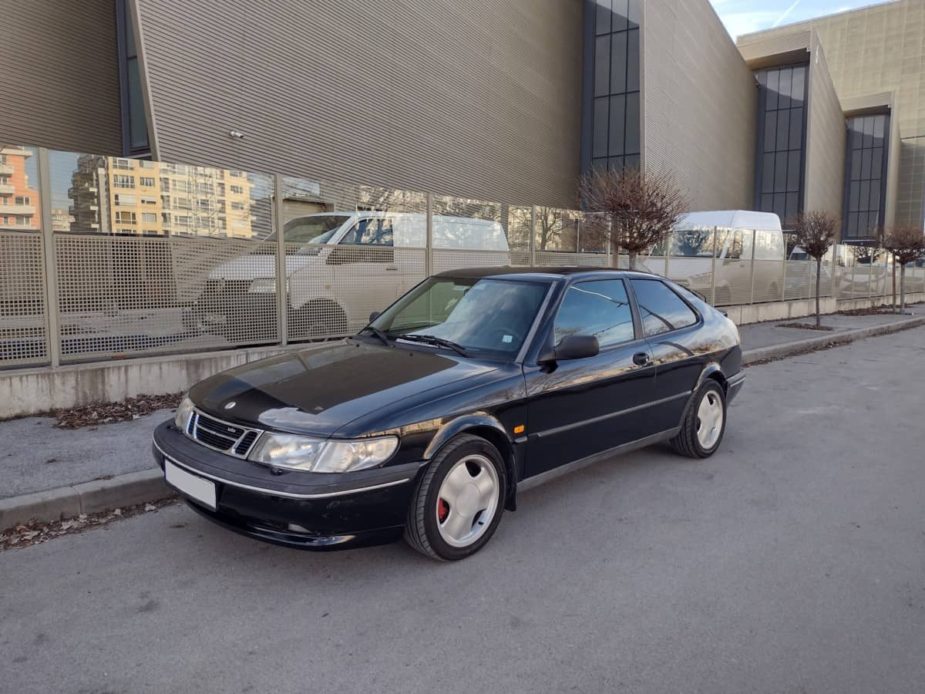
Today’s review car is no exception to Saab’s creed of car manufacturing. Internally designated NG, also called NG900, the second generation Saab 900 was produced between 1994 and 1998 in Trollhättan, Sweden (except the convertible produced in Uusikaupunki, Finland). After that, it was replaced by the suspiciously similar first-generation Saab 9-3. It was more of a facelift rather than a new car, although being adamantly marketed as a new model by the Swedish manufacturer. The NG900 was based on General Motor’s GM2900 platform and shared approximately 1/3 of its components with the Opel Vectra/Vauxhall Cavalier. It is only a front-wheel-drive vehicle and was offered in three versions – a 3-door hatchback, also called “combi coupé” (like our example), a 5 door hatchback and a 2-door convertible. Our car is from 1996.
Exterior
The car’s styling is controversial – it may be pretty for some and odd for others but is like nothing else from this period. The design is evolutionary from the original Saab 900, which, at the time of writing this article, gradually reaches sort of a cult car status and will probably become an expensive classic within the not-so-distant future.
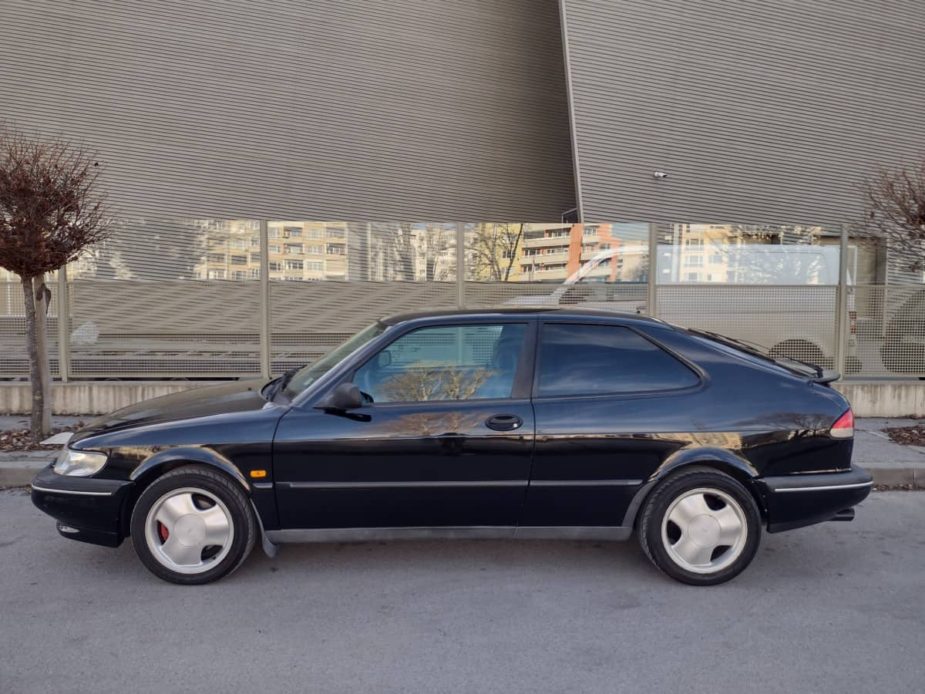
The NG900 is approximately 4.64 meters (15.1 feet) long, 1.71 meters (5.9 feet) wide and weighs about 1.3 tons. It’s a bit shorter than the first generation but is a nudge wider and taller, and the wheelbase has grown too. These changes, although minor, have given the car different irradiance than the original. Most noticeably for me is the shortened back. On the original Saab 900, the back bumper ends further away from the back wheels, creating the impression of a longer car at the rear. Also, looking at the older car from the side, the line of the fastback trunk lid is a bit steeper. These traits give a somewhat more elegant look to the vehicle. The NG900’s spoiler marks the end of the backside and ends it higher up. This changes the appearance slightly, emphasizing the look of a more compact car, which it is in terms of length.
Also, looking at the design, we have to note the rims. Our review car was equipped with the most prominent ones, which are 3-spoke 16-inch and resemble airplane propellers. The red brake callipers were an aftermarket thought. Originally they are dark grey. Also, the track of the car was widened with spacers. The factory look of the NG900 has the back wheels rather deep into the mudguards. Some of you will notice the darkened rear windows – also an aftermarket addition to the car. The spoiler is factory added and was not present only on the entry-level Saab 900. The front grill has the word “turbo” to the right side when looking at the car from the front. This is originally there for all turbo-powered Saab 900s. Also, you may have noticed the presence of the headlight wipers – something that the car industry has abandoned after the ’90s. The bumpers have an elegant white rubbery line that some may mistake for a chrome element.
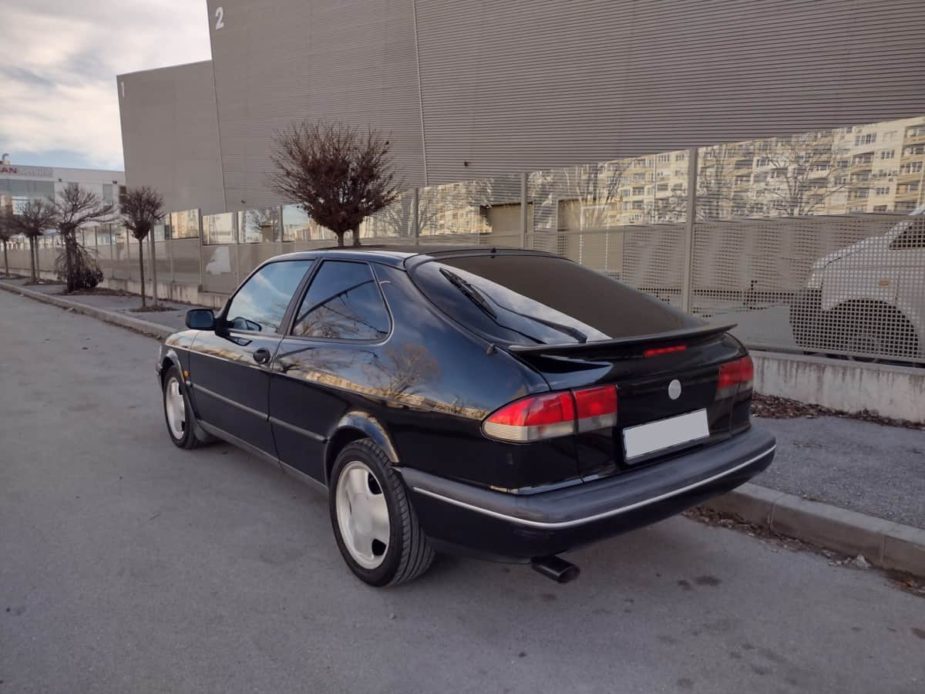
If you are interested in buying, be advised that Saab cars’ rust resistance treatment is proverbial. However, a lot of time has passed since this model’s production, so check for excessive corrosion on the bottom of the car and the wheel arches. Minor rust should not be neglected too, although it spreads slower on these cars compared to most other vehicles. You can check this article for our list of the least corroding automobiles (Saab is one of them).
Interior
Inside the car, things continue with the mild quirkiness. The centre part of the dashboard is slightly turned towards the driver and looks busier with buttons than your average car from the same period if with the stock radio. This was probably made on purpose again with airplane cockpit design in mind. Also, you will notice that the ignition keyhole is placed behind the gear lever. Saab was putting it there as a safety measure with the idea to protect the driver’s right knee in the event of a frontal collision accident.
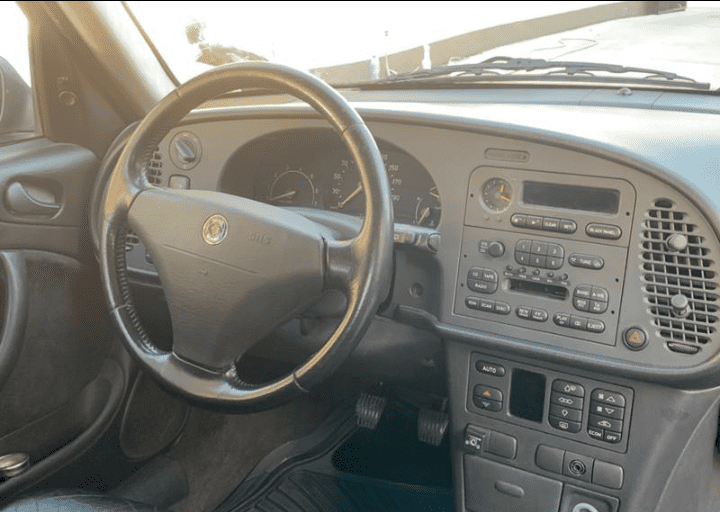
In terms of features, Saab cars were well equipped for the time if you opted for the S or SE trims. Our example is an SE and has central locking, an immobilizer, leather seats with lumber adjustment for the driver, automatic climate control, cruise control, electric windows and door mirrors, tape and CD player (which was replaced with an aftermarket one) and Saab’s info display, which provides data like outside temperature, time, fuel efficiency. A nice touch is also the analogue clock, positioned next to the information display. Maybe the most controversial feature is the Night Panel. Its function, according to Saab, is to remove all unnecessary distractions in terms of dashboard lights when driving at night. The Night Panel, being on, shuts down all gauges and their lighting apart from the speedometer. To be honest, I don’t find a real difference being on or off in terms of focusing at night, but this may be subjective, and others may find it useful. Things that our review car was not equipped with were heated front seats, memory for the driver’s seat and a sunroof.
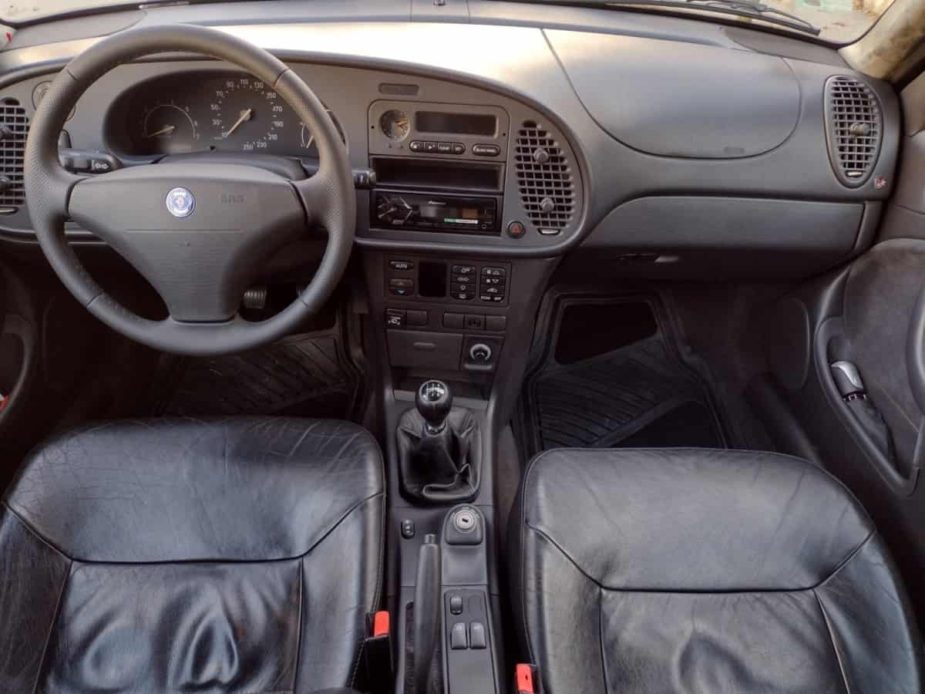
Regarding the materials inside – they are ok – not opulent but definitely above par and not feeling crappy. The steering wheel and gear knob are wrapped in leather. The dashboard is made from a soft plastic material, imitating being wrapped in leather too. The buttons are plastic and have a nice, sturdy and tactile feel. The dashboard around the steering wheel and controls could have been ordered in different looks, including mahogany. On our car, it is thick, grey, no-rattle plastic, which does not fight with the rest of the colours and gives a more streamlined look to the interior of this Saab 900. The ceiling and pillars are alcantara, but this is not original. From the factory, the car gets the standard we all know – light, almost white-coloured cloth.
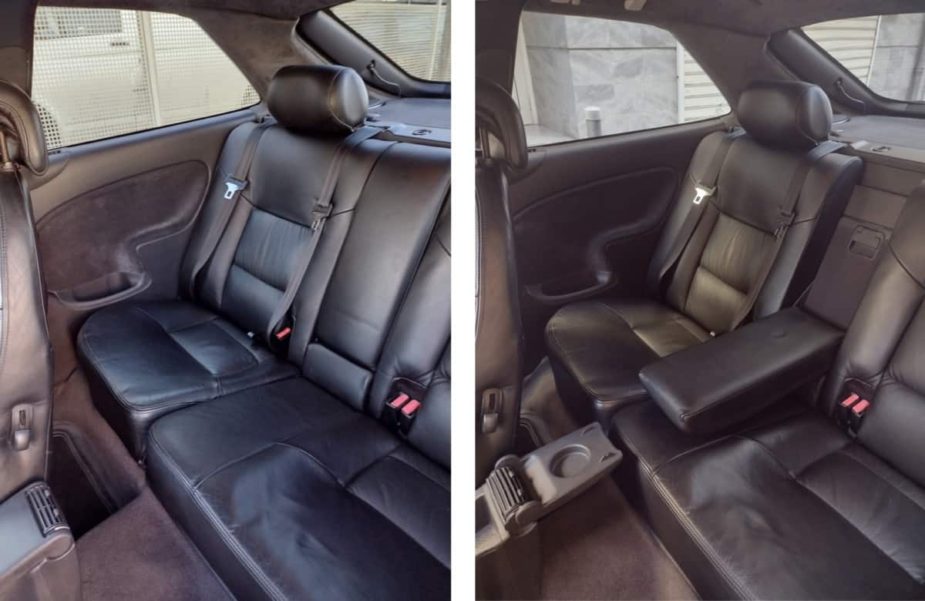
The space is fine in front and back, comparable with a BMW 3-series or a Mercedes C-klasse from the same period. The rear seats also get air ducts from the back of the centre console, although not the same quirky style as the front ones, and a middle foldable armrest. Behind it is an opening to the trunk, which can be used as a ski pass-through. One drawback is that Saab hadn’t provided even one cup holder in an easy to reach place to the driver. There are two, I would call them indentations for cups, when you open the glove box, similar to other Opel models from the same period. They are not very good though, as they are shallow and not very convenient since the glove box must stay open for them to be utilized. This will take from your front-seat passenger’s legroom and general comfort. There is one more indentation for a small cup, meant for the rear seats, which is accessible when you flip the lid of the little storage compartment between the front seats backwards. Otherwise, the glove box itself is spacious and speaking of space, we have to discuss the trunk, which is huge. No wonder Saab calls it a “combi coupé”. With a volume of 494 litres (17.45 cu. ft.), it is more than the BMW 5-series e39 Touring (the estate version) with whole 84 litres. The back seats are also foldable and then you get something like a pickup truck trunk space inside. There is also a ski luggage pass-through.
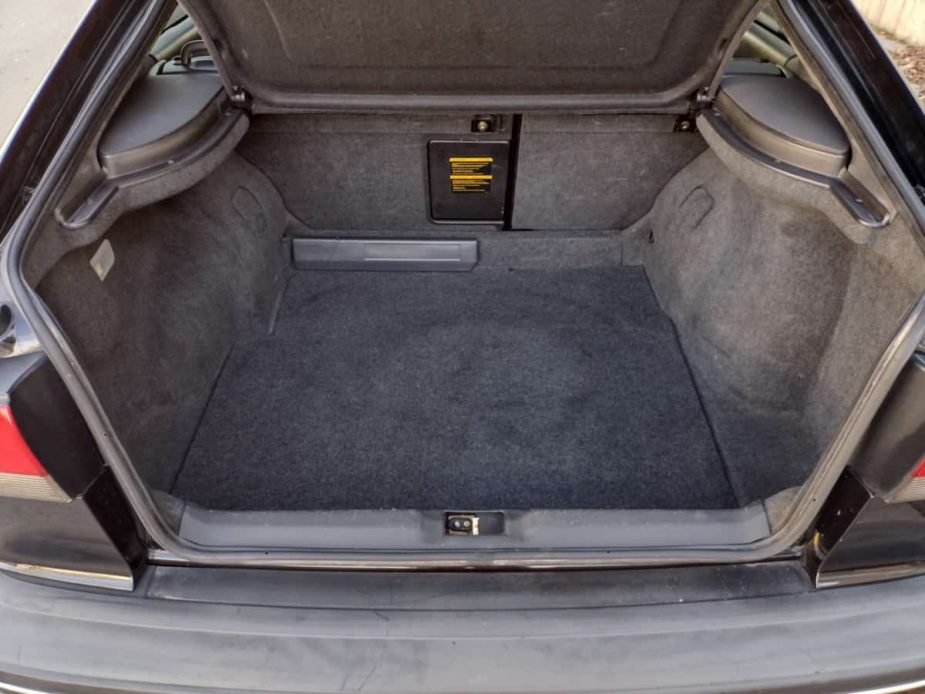
Regarding the security of the occupants, the 2nd generation Saab 900 was supplied with two front airbags – one for the driver and the front passenger. Although Saab boasts with and is renowned for excellent security, in a crash test, from 5-stars, Euro NCAP rewards the NG900 only a star and a half. Contradictory, the NHTSA has given it a 4 of 5-star safety rating for the driver and front passenger for a frontal crash, performing only this type of test.
Engines
There were three engine options to choose from – a 2.0 and a 2.3-litre 4-cylinder ones and a 2.5-litre V6. All engines are good, but we will discuss primarily the one in our review car – the 2.0. Internally it is called B204 and it is quite renowned among good tuning specialists for being one of the sturdiest engines ever built and having an enormous tuning potential. Our 2.0 Turbo review car had undergone such a treatment and produces about 250 hp, while from the factory, it was set on 185. If you are thinking of upgrading too, get yourself an Automatic Performance Contol module (APC) from a Saab 9-5 and change the 900’s one with it, as it is better suited for tuning. And if you are interested in tuning even further, I have sought the advice of a professional tuner who claimed that approximately 600 hp is totally manageable by the b204 without any interventions to the engine itself. That is only turbo and intercooler upgrades. They have done it, and the motor handles it with no issues in the long run too. The particular car they have tuned is still hunting the streets for unassuming supercar owners several years after the upgrade. Not that we recommend going for any more than 300 hp on your Saab as, being an old front-wheel-drive car, it simply cannot put that much power on the road. For anything over 250 hp, you will start spinning the front wheels even at third gear when you step on the throttle. Due to the engine’s tuning capacity, and the fact that it can withstand severe punishments, it is often swapped for the block of other General Motor cars like some Opel/Vauxhall models or the Saab 9-5. You might ask why the 9-5 as it is a Saab too, right? The reason is that Saab was not integrating the b204 in the 9-5, but its successor – the b205, which was nowhere near as reliable or tunable. Maybe some other time we will check out this engine more in-depth.
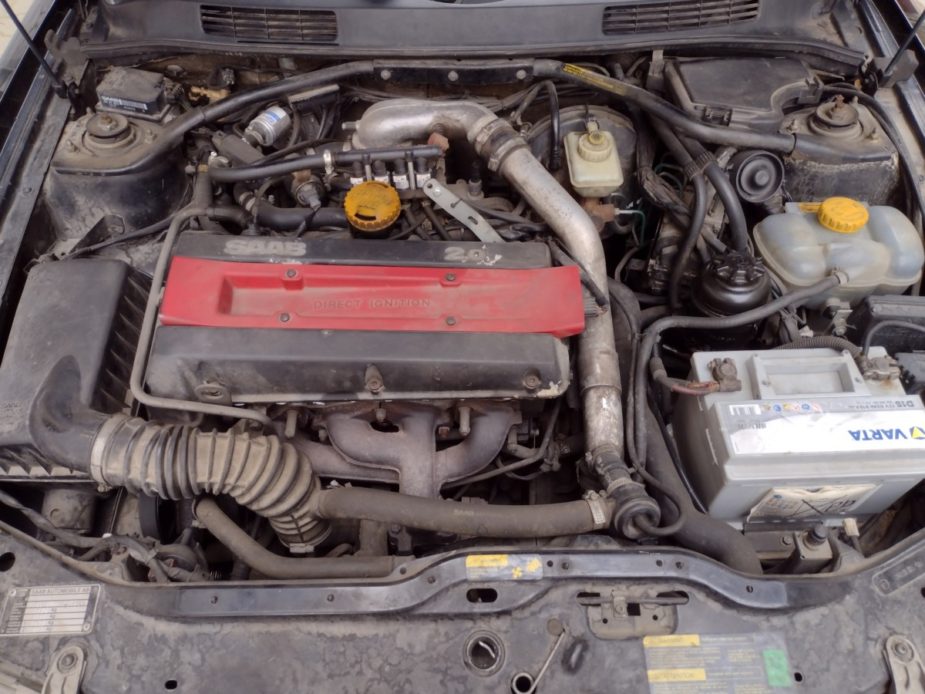
The block itself, as in the other two engine options, is made of cast iron and thus it is very resistant to overheating. Also, the engine features Saab’s native engine management system, called the Trionic. It is responsible for the timing of the ignition, the fuel injection and the boost control. We will not get into details but should mention that it is quite an ingenious system which Saab utilized to optimize their engines’ performance while lowering the chance of a misfire and emissions as much as possible on every stroke.
The camshafts of the 4-cylinder engines are with chains, while the V6 is belt-driven. Oil needs to be changed every 10’000 km or one year (whichever comes first), and it has to be 5W40. Also, I would like to mention that this engine is quite susceptible to LPG conversion. Our example car was “LPG-ed” sometime in the past, and it’s all been working great. No issues with the engine management, smooth driving, great power and no lights on the dashboard. We should point out that although hard to feel while driving on LPG, the engine seems to produce just a little bit less horsepower than when driving on 100-octane gasoline. You can think of it as being on an Eco mode, which it actually is.
In terms of engine issues, we don’t have almost anything to report. There are instances where you may encounter a bad fuel pressure pump. Another issue that may pop out is when you cold-start the motor, especially in chilly weather. The revs may start declining below one thousand, which is the normal operation for this power plant, and the engine may even get shut down. This will usually be because of the climate control. It is good to turn off the ACC when you start the car and keep it off at least until the engine has reached normal working temperature.
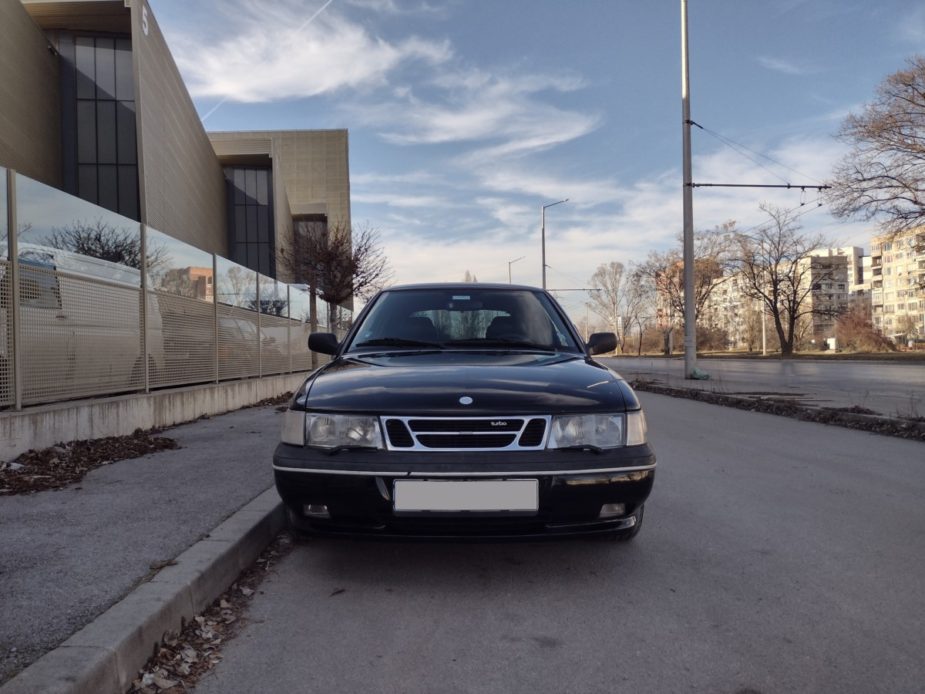
And that’s it really. Of course, we have to remember that this is an old car and so the hoses are also old (if not changed already). That being said, if they are not in shape because of their age, you may expect some coolant leaks here and there as in any other older car. The good thing is that the engine is cast iron, as already mentioned, hence it is immensely resistant to heat. So even if the engine overheats, you can expect that there will not be damage once it cools down again.
Transmissions
There were three options to choose from when it came to transmission in the Saab 900 – a five-speed manual, developed by Saab, a four-speed automatic, produced by Aisin-Warner or the very quirky five-speed semi-automatic “Sensonic”, again a brainchild of Saab’s engineers. The unconventional nature of the latter came from it being a clutchless transmission, meaning that you had a regular stick shift, but the Sensonic electronics were meant to operate the gear shifts without a clutch, recognizing and reacting immediately to any changes made with the lever. The reason for this innovation, which didn’t really catch on, was that Saab wanted to provide faster gear changes since the electronics were able to shift quicker than an average driver. It was integrated only in the turbo model and was discontinued after Saab introduced the new 9-3 in 1998. Maybe some of you will already have guessed that it was not the most reliable unit. The Aisin four-auto was alright for its day and age, but if you want reliability, you have to go with the normal manual. Also, you should know that the four-speed auto tends to last less time when coupled with a Turbo 900.
Second to last, know that if you are looking to buy manual transmission coupled with a turbo (the best combination in terms of transmission reliability) and you intend to tune your 900, you will need a stronger clutch. Our example car was equipped with a clutch from Saab 9-3 Viggen capable of handling over 400 Nm of torque. And lastly – a few words for the manual transmission operation. Although very dependable, it is not very pleasurable to operate with. It has a rubbery and inaccurate feel to it plus its action is quite longer than what you’d want. This loses time if you’re going to accelerate hard and change gears fast. Our example was tuned with an aftermarket short shifter to make things better. And if you have driven one without this upgrade, know that it does make things much, much better! The car feels more tossable and eager along with the significantly refined changes and reduced shift times, so definitely consider this option, especially if you like to drive more dynamically.
Other components
This section will be allocated for a few words for some other major components apart from the engine and transmission. Let’s start with the suspension. At the front, it is Macpherson struts with an anti-roll bar and the back is a semi-rigid axel. The shock absorbers are gas. All is dependable and cheap to fix and should not give you any headaches. The breaks are disc and sometimes can endure less time than in other cars from the same period. You can identify heavy wear of the front breaks by the brake dust build-up on the front wheels. ABS was standard on all models.
One of the more prominent weak points of these cars was the steering rack. It used to have problems even when the vehicle was new and in a warranty. Also, while the 900 is cold, it may be harder to turn the wheel, and then gradually, the situation improves. The steering itself is rack and pinion and power-assisted but not too much, which has a good effect on the driving feel.
Next, if you are looking for a convertible, make sure you check its overall condition for wear and its smoothness of operation thoroughly. Other pain points may include some usual suspects, namely faulty door locks and the electric windows and mirrors. There are instances of the car’s antenna not working properly too, and also the front headlights wipers tend to not function well sometimes, getting stuck mid-course. Lastly, know that the badges of the 900 (front and rear) get worn out. This can be seen on our example car too. Although, it is quite nice like that, don’t you agree? Leaving the driver of the overtaken car to wonder what was that…
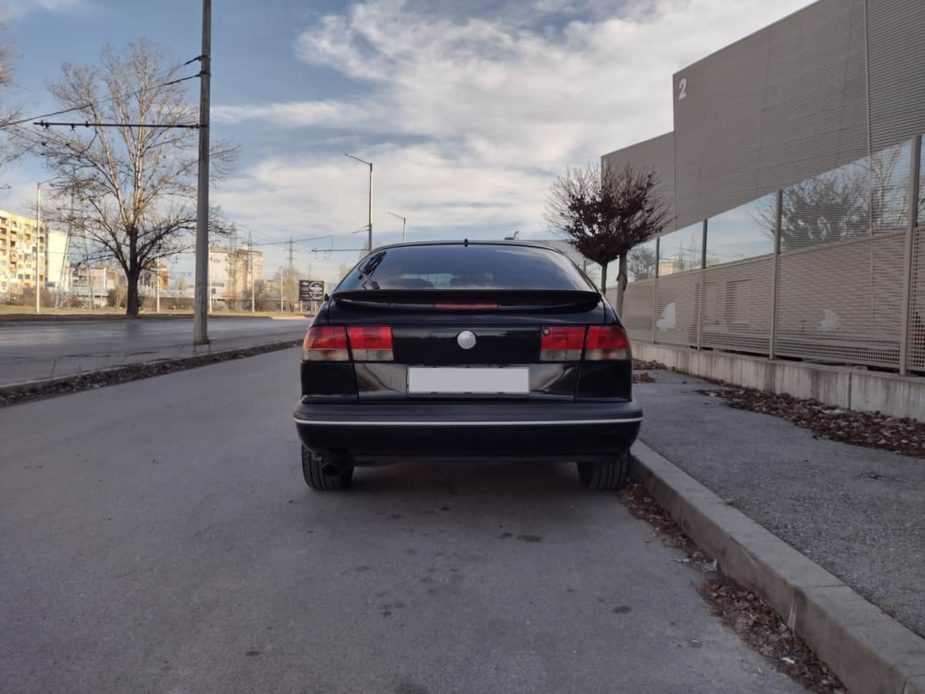
Finally, we have to mention something really special. A little known fact that deserves more spotlight attention, and I will use it to wrap up everything written above about the reliability of the NG900. In 1996 six random Saab 900s were picked up from the assembly line in Trollhättan to participate in arguably the most daring exhibit of Saab’s build quality. The sample vehicles, which included naturally aspirated 2.0s, 2.0 Turbos and 2.5 V6s, were checked and certified by FIA as stock cars with no modifications. Each of these 900s will have to be driven with the pedal to the floor for 40000 kilometres (25000 miles) on the rough Alabama’s Talladega Nascar speedway in the USA, which at the time definitely needed new tarmac. Its uneven surface and 33-degree bankings, generating up to 1.5G on the shocks, would provide high stress on the suspension, while the achieved astonishing average speed of 193 km/h (120 mph) with pit stops would stress everything else. The cars were driven at a maximum speed of 240 km/h (150 mph), only pit-stopping for fuel, tyre change, service and driver swapping. That was eight days and nights of non-stop abuse. The drivers were consisted of two professionals driving one of the cars on turns, while the other five Saabs were handed over to 120 journalists from all around the world, which will also take turns. The test was a total success. All cars have done 161 000 km (100 000 miles) cumulatively, breaking 40 world records for speed and endurance along the way. Only one car was taken out, and it was due to an accident with 220 km per hour, leaving the driver uninjured. And by the way, this was not the first Talladega challenge that Saab did. Ten years earlier, they went to the speedway with three standard Saab 9000s for a very similar test which was also a resounding success. You can see this Youtube video if you want to know more about these astonishing achievements.
To commemorate the above, Saab introduced the Talladega model of the 900 for the 1997 and 1998 model years, which included some small cosmetic touches but nothing in terms of performance improvements. It could have been bought with all engine options too.
Driving it
Saab cars were front-wheel drive, and although the NG900 has a rather confidence-inspiring, direct steering with good feedback and predictable handling, the driving characteristics and feel of the car are expectedly of a front-wheel-drive vehicle. There are also some downsides that will surprise in a not very pleasant way all people which had owned only Japanese or German cars. Let’s take something which is usually taken for granted by these people – the driving position. It isn’t really optimal. Either the gear lever will be a bit of a stretch, or the seat will never really assume the position you are most comfortable with, or something other minor will bother you slightly. This shouldn’t really surprise us. After all, Saab has never really been a mainstream manufacturer in the sense of the German or Japanese brands are so the personnel conceptualizing and building the Swedish cars were fewer. Some people find charm in this and it is understandable. It’s all part of the “left-fieldedness” of the brand.
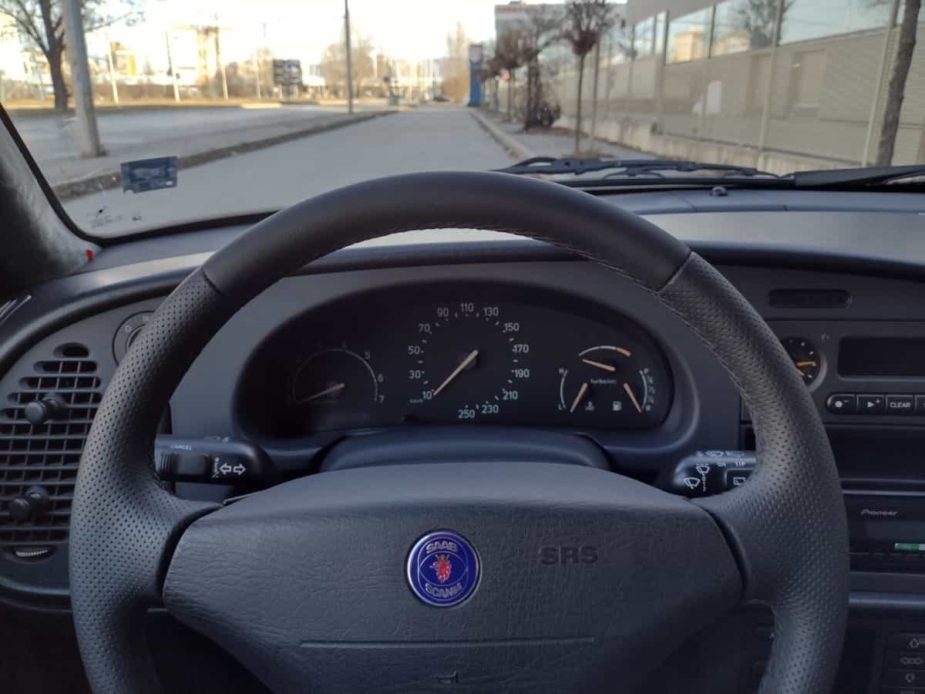
In terms of suspension – it is tuned somewhere between the comfort and sport setting. It is pleasantly tight without being harsh. You can feel that Saab had tried once more to provide their customers with one car for all occasions. As with many other automobiles from that era, the steering is a bit heavy but very manageable. This gives its reward in terms of road feel. Again, since the NG900 is a front-wheel-drive car, if you like taking corners fast, be aware that you may be subjected to some understeer. This happens if you have entered a bend more quickly than the chassis can handle, then you turn the steering wheel to take the turn, but the car refuses to follow your command. Basically, although the wheels are turned, the car continues straight or does not turn as much as you desire. If you want to mitigate this effect, you can put spacers on the wheels. They widen the track, allowing the car to handle better and be more stable, and also have a cosmetic effect, making it a bit fancier looking if the widening is appropriately chosen, of course. Our NG900 example has 0.5 cm on each of the front wheels and 3 cm on each of the back. Of course, don’t expect miracles, but this configuration really does improve the handling characteristics. So much so that with the spacers on, I shifted my focus from “using brakes in bends to prevent understeer” to “using brakes in bends primarily to stop me from squashing at the door or at my passenger” since the seats are not very supportive. Spacers may also be used if you would like to put bigger brake callipers. And speaking of callipers, the breaks of the Saab 900 traditionally are simply superb. They can stop the car quickly from any speed and have a good dosage.
Another aspect in which the Saab 900 Turbo really excels in terms of performance is speed. Saab was one of the first manufacturers that started the installation of turbos in their cars. And although exiting the factory, the cars with the 2.0 turbo engine were rather down-tuned to 150 or 185 hp, as already mentioned for a modest sum of money and approximately two hours work at almost any tuner shop, you could turn your Saab into a real road rocket. It is amusing to watch the pressure turbo gauge going crazy when you step on it. There is some old-school turbo lag which can be quite shocking for some drivers or passengers who have not experienced this before. The 2.0-litre engine itself produces 136 hp, so when the turbo spills in at about 2000 RPM, our example 900 practically nearly doubles its power almost instantly, harnessing the full 250 hp. Fast starts need some practice in this car since obviously there is no launch control and spinning the front wheels is super easy.
Extra-urban, the Saab 900 is great too. Although the road and wind noise can be a bit intrusive when driving over 110 km/h (68 mph), this is to be expected from an old car. You can try to heal this by smearing the seals with glycerol using a wool cloth or to just get new seals altogether. However, we have to say that even from the factory, the car was not very well sealed and road noise was something that the first owners had to put up with even when the 900 was new. The vehicle’s stability over high speeds, though, is great, and the elasticity which the turbo provides is marvellous for instant overtaking. This is also true in highway speeds since with 130 km/h (80 mph), the engine sits on exactly 3000 rpm, which is well within the turbo territory.
Conclusion
The second-generation Saab 900 is an interesting car indeed. With its quirky and distinctive design elements and interior decisions, it is easy to see why many people who sought to be different bought it. But the NG900 is more than just different. It was well made and rather luxurious. Also, the car industry and we – its customers, largely haven’t witnessed the 2.0-turbo tuning capacity in a long time.
Apart from the airplane analogies, Saab marketed their cars as being something like Swiss army knives, doing everything you could possibly want – being a utilitarian, sports, luxurious and prestigious car at the same time. And I personally would agree that they have succeeded in achieving this goal with the 900’s enormous trunk space, the turbo-engine performance, and the interior equipment. The high level of overall engineering attracted many highly educated people who remained loyal to the brand until its bankruptcy in late 2011. A shame that Saab is no more.